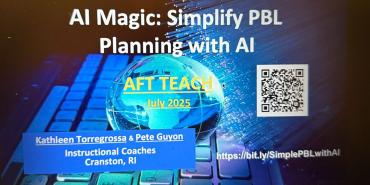Educators fed ready-made lesson-planning templates into artificial intelligence, chatted with AI-created podcasters and experimented with different AI models at AFT TEACH on July 27. But facilitators Kathy Torregrossa and Pete Guyon, both instructional coaches and members of the Rhode Island Federation of Teachers and Health Professionals, emphasized one key message: The art of teaching lives in empathy, relationships, creativity and real-time adaptation. AI can ease the load, but only teachers can keep learning meaningful.
“AI is super powerful for efficiency,” Guyon said, but “in the end, gadgets break. Teachers always change the world.”
Integrating AI into planning frees teachers to do what they do best, Torregrossa said: teach.
Why educators need to understand AI
“Our students are digital natives, but they need digital immigrants.” Torregrossa said. “We didn’t grow up with technology to support our learning,” she added. “The kids in our schools now have never had an educational experience that doesn’t allow them to talk to a device.”
That’s what it means to be a “digital native” as opposed to a “digital immigrant”—those of us who grew up with chalkboards and maybe an overhead projector.
But too often, “digital natives haven’t been taught to evaluate the responses they get from devices,” Torregrossa pointed out. Too many students “don’t understand digital privacy. They don’t know that when they let their phones read their text messages out loud, they’ve just invited a device into a private conversation.” As a result, she said, “Educators need to embrace technology because this is the world our students live in—and will eventually work in—and we need to teach them how to engage ethically and responsibly.”
Why project-based learning?
Project-based learning teaches kids another essential set of skills: problem-solving, research and collaboration. That final skill—collaboration—is especially important right now, Torregrossa said.
“Our kids grow up on screens now; they don’t go outside and make up the rules to games with each other,” she noted. Since many children are missing out on such opportunities to develop socialization and collaboration skills, project-based learning can help fill that gap.
Why and how to use AI in project-based learning
The “why” of using AI is clear: It provides ideas and plans educators can adapt, cutting down on planning time. The “how” requires a bit of learning.
The facilitators offered five key questions to remember when developing project-based planning prompts for AI:
- What are the big ideas and enduring understandings?
- What driving question or challenge will spark curiosity?
- Will students have access to the appropriate resources?
- How will students demonstrate their learning?
- Is there a balance between student choice and the structure needed to guide them?
Educators then used these questions and an example prompt to create their own lessons. Topics included ecosystems and animal habitats. One crucial lesson they learned is that project-based learning encourages agency, but students still need clear expectations and feedback.
The takeaway
In the end, the session wasn’t about asking AI to replace the role of the teacher; it was about reclaiming teachers’ time so they can focus on the things only humans can do: build trust, guide students through authentic problems and help students develop critical-thinking skills. The innovation doesn’t lie with the AI; it lies with the educator who uses it.
[Melanie Boyer]

